Q1 2012: QR Code Trends
The following data is based on the 1,400,000 QR codes created by our 1,000,000 website users during January, February and March 2012.Key Points
- Overall global QR Code activity is up 381% on Q1 2011 and up 16% on Q4 2011.
- The Top 5 countries (Untied States, United Kingdom, Canada, Australia and Germany) have remained the same however their collective share of global QR code activitiy has decreased marginally since Q4 2011.
- While the relative proportion of global QR code activitiy for the USA decreased from 49.0% in Q4 2011 to 48.1% in Q1 2012, QR code activity in absolute terms increased by 14% in the USA over the same period.
- Email and SMS QR codes have increased in popularity at the expense of QR codes containing a website URL. Google Maps QR codes also showed a strong increase in popularity.
- The disparity in device type used for scanning appears to have stabilised at approximately 60% iOS and approximately 30% Android.
While the stratospheric year-on-year growth rates seen through 2011 (albeit off a low 2010 base) have begun to tail off somewhat, significant increases between Q4 2011 and Q1 2012 were recorded for all countries in the top 20 with the exception of the Netherlands, that showed a reduction of 6%.
Overall the yearly growth rates reflect the adoption cycle of QR codes with earlier adopters like USA and Canada now stabilising in growth rates, while Europe exhibited in the last 2 quarters the sort of growth rates that North Amercia saw in Q3 and Q4 last year.
As the major markets that are using QR codes each move past the stage of over-heated and frenzied hype and opportunistic “snake oil” marketing, a much more solid and structured phase of adaption and deployment will follow characterised by marketers becoming more experienced and mature in their use, advertisers having a more realistic expectation of the role QR codes can play in their promotional mix, and the general consumer becoming more familiar with seeing them around.
| Position | Country Of Origin | % Of Global Total | % Increase | |||
| Q1 2012 | Q4 2011 | Q1 2012 | Q4 2011 | Q4 11 to Q1 12 | Q1 11 to Q1 12 | |
| 1 | 1 | United States | 48.1% | 49.0% | 14% | 314% |
| 2 | 2 | United Kingdom | 12.1% | 11.9% | 18% | 644% |
| 3 | 3 | Canada | 5.1% | 5.3% | 13% | 298% |
| 4 | 4 | Australia | 3.5% | 3.7% | 10% | 565% |
| 5 | 5 | Germany | 2.4% | 1.9% | 47% | 561% |
| 6 | 7 | India | 1.8% | 1.6% | 25% | 500% |
| 7 | 8 | Denmark | 1.7% | 1.6% | 25% | 439% |
| 8 | 9 | Mexico | 1.4% | 1.5% | 12% | 935% |
| 9 | 6 | Netherlands | 1.4% | 1.7% | -6% | 202% |
| 10 | 12 | Singapore | 1.0% | 0.9% | 30% | 564% |
| 11 | 11 | France | 1.0% | 0.9% | 24% | 229% |
| 12 | 10 | Malaysia | 1.0% | 1.1% | 2% | 943% |
| 13 | 15 | Spain | 0.9% | 0.8% | 33% | 338% |
| 14 | 14 | New Zealand | 0.8% | 0.8% | 16% | 721% |
| 15 | 13 | Norway | 0.8% | 0.8% | 8% | 969% |
| 16 | 16 | Brazil | 0.7% | 0.8% | 6% | 444% |
| 17 | 17 | Italy | 0.7% | 0.7% | 17% | 135% |
| 18 | 14 | Sweden | 0.7% | 0.6% | 38% | 463% |
| 19 | 26 | Turkey | 0.7% | 0.5% | 59% | 579% |
| 20 | 20 | Israel | 0.7% | 0.6% | 24% | 702% |
| Total | 86.4% | 86.6% | 16% | 381% | ||
One interesting take-out when looking at the underlying data is that while the number of QR codes created at QRStuff.com increased by 16% between Q4 2011 and Q1 2012, the number of scan events recorded increased by 156% over the same period indicating a strong growth in the ongoing level of user engagement with those QR codes created and published in previous months.
QR Codes Created
As predicted in our 2011 Trend Report, QR codes containing email messages and SMS messages have increased significantly in popularity, as have QR codes containing Google Maps locations, with that increase being at the expense of QR codes containing a website URL.
| Position | Content Of QR Codes | Percentage Of Total | % Increase | ||
| Q1 2012 | Q4 2011 | Q1 2012 | Q4 2011 | Q4 to Q1 | |
| 1 | 1 | Website URL | 60.3% | 66.4% | 6% |
| 2 | 2 | Plain Text | 15.3% | 14.5% | 23% |
| 3 | 3 | vCard Contact Details | 10.6% | 9.9% | 25% |
| 4 | 4 | Social Media Links | 3.4% | 2.4% | 60% |
| 5 | 7 | Email Address | 2.4% | 1.0% | 178% |
| 6 | 6 | Google Maps Location | 2.4% | 1.1% | 141% |
| 7 | 5 | Youtube Video Link | 1.9% | 1.7% | 32% |
| 8 | 10 | Email Message | 1.1% | 0.5% | 143% |
| 9 | 9 | SMS Message | 1.0% | 0.7% | 67% |
| 10 | 8 | Phone Number | 0.8% | 0.9% | 5% |
| Total | 99.2% | 99.3% | 17% | ||
iPhones are still the most popular devices used for scanning QR codes. While Android devices showed some sign of narrowing the gap in Q3 and Q4 2011, the disparity is now pretty much 2:1. Blackberry’s continue to rapidly slide in popularity, however Windows Mobile devices have gained some of the ground they lost earlier in the year.
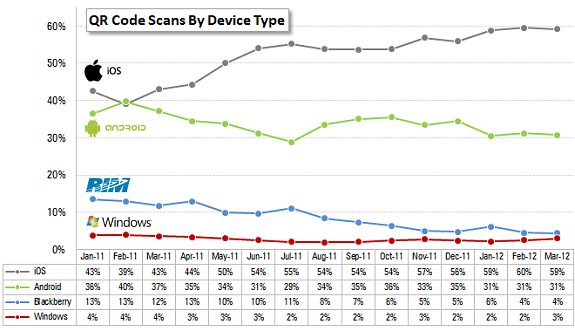
We still hold to the point of view that the scanning apps available for iPhone users are of a significantly higher quality and sophistication leading to higher useage rates, higher user satisfaction and higher user retention for iPhones compared to other devices.
The continuing publication of QR codes that are too dense to be read by a smartphone that doesn’t have a high resolution camera and/or optical image stabilisation will also continue to bias useage rates in favour of iPhones and away from older or less sophisticated devices on other platforms that give the user a less satisfactory scan result.
4,000,000 QR Codes And Counting…
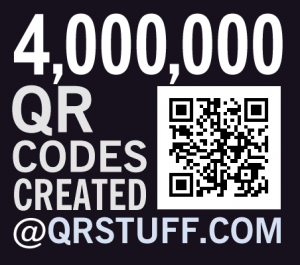 On March 20 2012 we racked up another milestone – 4,000,000 QR codes created by our users at QRStuff.com.
On March 20 2012 we racked up another milestone – 4,000,000 QR codes created by our users at QRStuff.com.It took 3.5 years for our first million QR codes, 3 months for the second million, 12 weeks for the third million, and just short of 8 weeks for our fourth million.
Who says the growth in QR codes is tailing off?
QR Code #4000000
Highlighting the diverse range of users that we have, the 4 millionth QR code seemed to part of an elementary school class lesson on QR codes and contained the following cute message in plain text:
Hi my name is Tyler and my favourite couler is purple and I am 9 and my friends are Conor Jordan Bobbie Indi and sarha also my favourite teacher is miss Mattews and I am the coolies girl in the would
Thanks Tyler (and Miss Mattews) for helping us to get to a record number of QR codes.QR Codes In Tourism And Travel
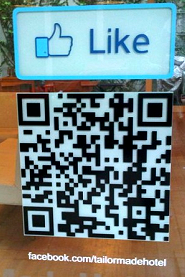 If you’re planning on using QR codes in the tourism or travel industry the opportunities go way beyond simply adding a QR code to the back page of your brochure that links to your website.
If you’re planning on using QR codes in the tourism or travel industry the opportunities go way beyond simply adding a QR code to the back page of your brochure that links to your website.As the articles shown below point out, QR codes in tourism, travel and hospitality can be used for product and destination marketing, in-house guest engagement, interpretive signage, adding multimedia dimensions to self-guided tours, and linking online content to traditional print media.
- How Hotels Can Use QR Codes For Marketing And Customer Service: Using QR codes to improve a guest’s service experience. QR codes are used on cards in the rooms, notices in elevators, at the concierge desk and message boards in the lobby to engage clients with tips on where to dine or what to do during their stay. Here’s the original article by Xotels.
- Increasing Print Catalog Engagement With QR Codes: Luxury villa rental company Wimco recently released its annual Vendôme Guide to St. Barts with a multitude of QR codes that lead consumers directly to mobile-optimized real estate listings for the first time.
- 4 Ideal Tourism Uses for QR Codes: An increasingly popular marketing tactic for the tourism industry, QR codes provide a unique link between the physical world and a limitless supply of digital content.
- 12 Ways Your Travel Brand Could Use QR Codes: QR codes are a great way to connect prospective guests who are offline to information about your brand that is online. Just make sure your site is mobile-friendly and you offer some kind of value-add.
- Implementing QR Codes to Enhance Hotel Guest Interaction and Revenue: The future holds more interesting uses for the technology, especially in the hotel industry, as we learn how to better connect with and respond to our guests.
- Hospitality Industry Using QR Codes to Improve Guests’ Experience: The hospitality industry has come up with some interesting ways to use them to help ensure that guests enjoy their stay.
- Smart Scanning: Six Savvy Hotels Using QR Codes: Real-life examples of hotel and conference centers incorporating QR codes into their hospitality marketing with success.
- QR codes and Mobile Apps: What can they do for Destination Marketing? QR codes will certainly revolutionize what we can do as marketers to reach customers – but must be used at the point of consumption, or close to the end of the travel buying cycle. Here’s the original article by acoupleofchicks.com Digital Tourism Marketing.
- The Rise and Success of QR Codes in London: Innovative adaptations of QR codes in London have made visiting this popular tourist destination easier, with London attractions available at the touch of your smart phone.
- Examples of using QR codes to integrate multimedia and online content into interpretive signage and self-guided walking tours – San Antonio (Texas) River Walk, Grand Rapids (Michigan) Historical Tour, New York City Gotham Guide , Napier City (New Zealand), Ding Darling National Wildlife Refuge (Florida), Pheasant Valley Winery (Oregon), Long Beach (Washington) Discovery Trail, various museum tours, and the Explore Cebu (Philipines) Heritage Tour.
- North Wales Tourism QR Code Revolution: QR codes have been used on a quarter of a million Great Days Out leaflets to be distributed across North Wales, the North West and the Midlands. The QR codes direct smartphone users to a website that is constantly updated with the latest information so that the leaflet doesn’t become outdated, effectively extending the useful life of the printed product.
- QR Codes for Lodging Seminar (Mid-Atlantic Innkeepers Conference 2012) and 15 QR Code Ideas For Bed And Breakfasts
- Our earlier blog post on Making A Google Places QR Code
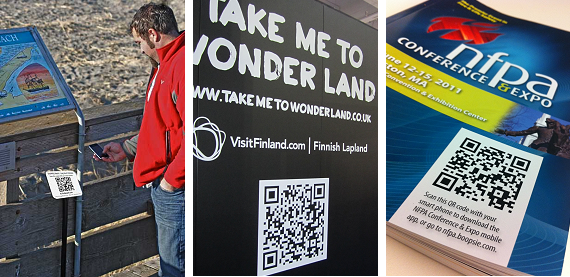
Finally, here’s a video that highlights, in a humorous way, a few of the pitfalls to avoid when putting a QR code campaign together.
Image Sources: www.skipedia.co.uk, www.hotelmarketingstrategies.com, www.funbeach.com, www.3seventy.com
B2B or B2C: How Can Your Business Use QR Codes?
 Carol Roth is a business strategist, deal maker and author of the New York Times, Wall Street Journal and USA Today bestselling book, The Entrepreneur Equation. Carol is a frequent radio, television and print media contributor on the topics of business and entrepreneurship, having appeared on Fox News, MSNBC, Fox Business, WGN TV Chicago and more. Additionally, Carol’s Unsolicited Business Advice blog at CarolRoth.com was recently named as one of the Top 10 small business blogs online.
Carol Roth is a business strategist, deal maker and author of the New York Times, Wall Street Journal and USA Today bestselling book, The Entrepreneur Equation. Carol is a frequent radio, television and print media contributor on the topics of business and entrepreneurship, having appeared on Fox News, MSNBC, Fox Business, WGN TV Chicago and more. Additionally, Carol’s Unsolicited Business Advice blog at CarolRoth.com was recently named as one of the Top 10 small business blogs online.For example, for the Philadelphia Phillies, using QR codes was a way to solve two problems with one small square. The team wanted to move away from its traditional “schedule cups” – on which the season’s schedule accounted for more than half of the cup’s available space – and wanted to provide more memorable cups that showcased the team’s formidable stable of talent.
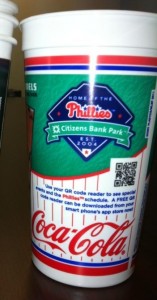
- The Phillies saved valuable space by making their schedule reachable through scanning the QR code; Acme Paper & Supply Company used this solution for other products they have produced for customers as well, such as coffee cups. More information is at www.acmepaper.com
So, you can see that Acme Paper & Supply Company integrated the QR code in a Business-to-Business endeavor, while the Phillies baseball team used the code to engage its fans (a Business-to-Consumer model). Moreover, regardless of who your customer is, remember to have a strong benefit tied to your efforts.
Finally, remember that while there are almost no limits to how you can use QR codes, it’s the results that count. Like in other areas of technology, many businesses are better at creating them than monitoring them. If you are going to take the time to create them and use them creatively, make sure to monitor their efficacy as well.
1253% Increase In QR Codes In 2011
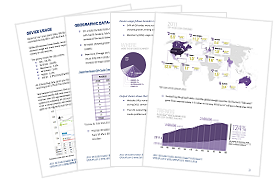 We have just released our inaugural QR Code Trends Report on QR code creation and scanning. During 2011 more than 2.7 million QR codes were created at QRStuff.com putting us in a unique position to report on the trends of QR code creation and related scan events.
We have just released our inaugural QR Code Trends Report on QR code creation and scanning. During 2011 more than 2.7 million QR codes were created at QRStuff.com putting us in a unique position to report on the trends of QR code creation and related scan events.Click here to download the full 11 page report.
Report Highlights:
- There was a 1253% increase in the number of QR Codes created during 2011; While it took three and a half years for the first million QR codes to be created on the QRStuff.com website, the second million came around in less than three months, with that milestone being reached at the start of Q4 2011.
- The United States, Canada and the UK lead in QR code creation and scanning, with 69% of QR codes created and 87% of scan events recorded;
- There has been an increase in QR code activity in rural and regional areas (non-metropolitan) in the US;
- Globally, the use of QR codes is on the increase with scan events recorded from 200 countries during 2011 (up from the 142 in 2010). Late in the year, we recorded scan events from Cape Verde, Eritrea, Sierra Leone, Togo and Turkmenistan for the first time ever;
- Despite having over 20 QR code data types available, over 63% of all QR Codes created were linked to a website URL;
- 54% of QR Codes scans were done using iOS devices, with iPads accounting for almost 2% of all scans;
If you require more information about this report please email pr@qrstuff.com
A Shrinky Dinks QR Code Dog Tag
 I saw a tweet the other day from Sarah announcing that she’d made a Shrinky Dink dog tag from a QR codes she’d made at QRStuff.com so I emailed her for some more information.
I saw a tweet the other day from Sarah announcing that she’d made a Shrinky Dink dog tag from a QR codes she’d made at QRStuff.com so I emailed her for some more information.The process I followed to make my dog tags was as follows:
- Create a vCard QR code with your contact details at www.qrstuff.com.
- Download the QR code image and enlarge it to 3 times the desired finished size.
- I hand traced it onto some Shrinky Dinks plastic although they’ve got an InkJet printer version now.
- Cut out desired shape and punch a hole in it.
- Bake it as per the manufacturer’s instructions.
- Insert a jump ring into the hole and thread some bead chain through jump ring.
- Attach to dog.
QR Code Error Correction
Part of the robustness of QR codes in the physical environment is their ability to sustain “damage” and continue to function even when a part of the QR code image is obscured, defaced or removed.This is acheived by using the Reed-Solomon Error Correction algorithm – some serious algebra that happens in background when the QR code is created. The original data in the QR code is converted into a polynomial, the number of unique points required to uniquely define that polynomial is determined, and this point set is added back into the QR code so that it then also contains the original data expressed as a polynomial.
If that description threatened to make your head explode, just call it “mathematically adding backup data to the QR code”.
There are 4 error correction levels used for QR codes, with each one adding different amounts of “backup” data depending on how much damage the QR code is expected to suffer in its intended environment, and hence how much error correction may be required:
- Level L – up to 7% damage
- Level M – up to 15% damage
- Level Q – up to 25% damage
- Level H – up to 30% damage
Quite conveniently, there’s also 2 modules down in the bottom left-hand corner of every QR code that display what the error correction level used in that QR code is.
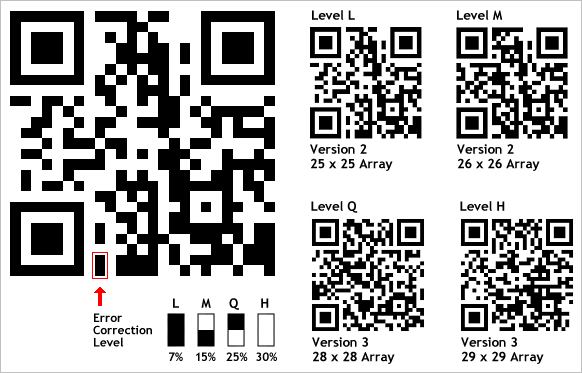
So here are the take-outs:
- The lower the error correction level, the less dense the QR code image is, which improves minimum printing size.
- The higher the error correction level, the more damage it can sustain before it becomes unreadabale.
- Level L or Level M represent the best compromise between density and ruggedness for general marketing use.
- Level Q and Level H are generally recommended for industrial environments where keeping the QR code clean or un-damaged will be a challenge.
This doesn’t mean that any particular QR code generator is any more or any less standards-compliant than any other, it just means that the people behind the different generators have made different choices when setting the underlying technical specifications and parameters for the QR codes that their website creates.
Top 10 QR Code Tech Support Questions
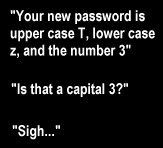 One of these questions actually came in overnight which prompted me to think that I should probably share with you some of the more “interesting” customer tech support questions I’ve had over the past 3 and a bit years.
One of these questions actually came in overnight which prompted me to think that I should probably share with you some of the more “interesting” customer tech support questions I’ve had over the past 3 and a bit years. These are real questions from real people and indicate that the QR code learning curve is a bit steeper for some, but I endeavoured to answer all of them in a helpful and respectful manner.
In no particular order, here’s my 10 favourites:
- My phone doesn’t have a camera. What scanning app should I use?
- I made a QR code with my cell phone number in it but every time I scan it with my phone I get my voicemail. Can you help me to get it to work?
- I put a QR code for my website in my email signature but when I click on it nothing happens. What am I doing wrong?
- Can you make a QR code that links to another QR code?
- If I change the color of my QR code will it still link to the same website?
- I scanned a QR code in a magazine ad and it took me to their website but they didn’t have what I wanted. Can I make it go to another website?
- The QR code works fine using the camera my iPhone, but why won’t it scan with my digital camera?
- My QR code links to a Powerpoint that’s on my home computer. Why won’t it work at my office?
- Can your analytics tell me how many people saw our QR code but didn’t scan it?
- Why do my QR codes only scan properly when the internet on my phone is turned on?
US QR Code Activity: Nov 2011
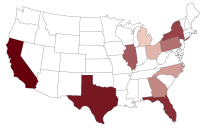 Here’s some insights into the way the QR world was in November from our database of 2.35 million QR codes created on the QRStuff.com website.
Here’s some insights into the way the QR world was in November from our database of 2.35 million QR codes created on the QRStuff.com website.Looking at the way the website is being used, the QR codes that are being created, and the scan events that are being recorded, the hotspot cities and states for overall QR code activity during November, together with the relative increase in activity over the past 6 months for that city or state, were as follows:
|
| ||||||||||||||||||||||||||||||||||||||||||||||||||||||||||||||||||||||||
QRlicious Make Custom QR Codes Easy
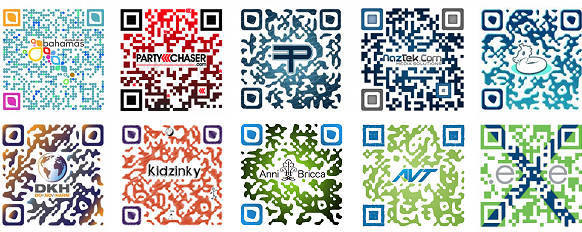
If you’re after a custom QR code you need look no further than QRlicious. Logos, branding, colors, and cool graphic effects that your customers won’t be able to resist scanning.
And if you have a QR Stuff subscription (even a 24 hour $3.95 subscription) here’s how easy it is to create your QR code and get it over to the boys at QRlicious for customising:
Geen opmerkingen:
Een reactie posten